Perpetual Card: Vaticinia Varia: Difference between revisions
No edit summary |
|||
| (20 intermediate revisions by the same user not shown) | |||
| Line 1: | Line 1: | ||
[[File:London Calendar.jpeg|300px|thumb|right|Photo 1.1 Title Page, a calendar of the year 1688]] | |||
[http://hdl.library.upenn.edu/1017/d/medren/9943207803503681 Perpetual card: Vaticina Varia] is a manuscript hand-written by an unknown author, detailing various fortune telling methods and astrological conventions. The name perpetual card means a perpetual calendar, sometimes also called an infinite calendar. This manuscript contains a calendar for the year of 1688, explanations on how to calculate the date for feasting and traditional holidays, as well as extensive examples and notes on astrological predictions. Perpetual card approaches the art of fortune-telling through numeric calculations, Christian traditions, and astrological observations. This manuscript was originally collected by the [https://www.library.upenn.edu/collections/special-notable/groups/henry-charles-lea-library Henry Charles Lea Library], and now stored in the[https://www.library.upenn.edu/kislak Kislak Center for Special Collections, Rare Books and Manuscripts at the University of Pennsylvania]. | [http://hdl.library.upenn.edu/1017/d/medren/9943207803503681 Perpetual card: Vaticina Varia] is a manuscript hand-written by an unknown author, detailing various fortune telling methods and astrological conventions. The name perpetual card means a perpetual calendar, sometimes also called an infinite calendar. This manuscript contains a calendar for the year of 1688, explanations on how to calculate the date for feasting and traditional holidays, as well as extensive examples and notes on astrological predictions. Perpetual card approaches the art of fortune-telling through numeric calculations, Christian traditions, and astrological observations. This manuscript was originally collected by the [https://www.library.upenn.edu/collections/special-notable/groups/henry-charles-lea-library Henry Charles Lea Library], and now stored in the[https://www.library.upenn.edu/kislak Kislak Center for Special Collections, Rare Books and Manuscripts at the University of Pennsylvania]. | ||
==Manuscript Structure== | ==Manuscript Structure== | ||
[[File: | The book begins with a title page of a circle illustration with the words “London 1688” written in the middle (see photo 1.1). Numbers and dates surround the words in the middle. It is thus inferred that the manuscript was written in the year 1688, in London. However, this may not necessarily be the time that this manuscript was bound together into a notebook with gilt calf. From eye observation, the calf binding appears to be from a much newer date (see photo 1.2). | ||
[[File:Calf Binding.jpeg|200px|thumb|left|Photo 1.2 Gilt calf binding with delicate patterns pressed in. The side of the book shows signs of rebinding of manuscript. The side of the gilt calf details “London, 1688,” with words pressed in and gilted]] | |||
[[File:Marbled_Paper.jpeg|200px|thumb|right|Photo 1.3 Marbled paper glued together between the front cover and the title page. A similar sheet of marbled paper is seen at the end of the manuscript, glued between the back cover and the last page.]] | |||
There is a possibility that the book may have been rebound again by the collector or later readers. The patterns on the calf are delicately pressed and adorned with gilt. On the right side, there appear to be two metal locks, perhaps purposed for locking the content of the book away from common readers. Whether these locks were initially created to be functional or ornamental remains a question. If these locks were functional, they, in part, reflect the nature and history of astrological fortune-telling. Manuscripts like these were not written for the masses but rather for a small number of people who studies the occult. The methods and calculations for astrological predictions were largely exclusive to certain groups of people and not easily accessible. At its present stage, the metal locks do not appear to retain any particular purpose (i.e. locking up the text). | |||
Another clue to why the manuscript may be written and bound at different time periods lies in the pattern of the marbled paper glued between the outer calf layer and the first page. This manuscript begins and ends with sheets of delicately-created marbled paper, consisting of deep red, sky blue, white, and light yellow oil colorings (see photo 1.3). This marbled paper is made in the [https://digitalcollections.lib.washington.edu/digital/collection/dp/id/283/rec/8 nonpareil pattern],<ref name="Vintage 19th c. Marbled Paper"> “Vintage 19th c. Marbled Paper, Nonpareil Pattern.” University of Washington Libraries, Special Collections, [DEP0110]. Accessed April 1, 2022. https://digitalcollections.lib.washington.edu/digital/collection/dp/id/283/rec/8. </ref> which was seen predominantly in 19th and 20th century.<ref name="The Bibliographical Description"> Tanselle, G. Thomas. “The Bibliographical Description of Patterns.” Studies in Bibliography 23 (1970): 71–102. http://www.jstor.org/stable/40371502. </ref> One theory could be that the manuscript was first written in 1688, but later bound together into a notebook with a nice calf book cover by a collector, one or two centuries later. The date indicated on the title page possibly does not match that of the cover and the marbled paper. | |||
The entire manuscript consistently employs brown or black colored ink to write notes, to draw astrology patterns and signs, as well as to outline and shade themed illustrations. | |||
[[File:English_Paper.jpeg|200px|thumb|left|Photo 1.4 Pages with English notes detailing how to calculate different dates and festivals using the perpetual calendar]] | |||
==Book Content== | |||
This manuscript tackles a diverse range of topics, demonstrating methods of astrological calculations and predictions that require prior knowledge in the field. | |||
The entire manuscript was numbered by its author in terms of pages. It begins with some handwritten notes in English, explaining in detail how to use the perpetual calendar to calculate festivals and important dates of a year, including the date for Easter and for feasts (see photo 1.4). The first twelves pages of English notes are separated from the rest of the book, marked from “i” to “xii”. After the introductory notes, the manuscript officially begins on page “1”. Starting from this page, the writer turns to using Latin as the language of communication. | |||
[[File:Circle_Graph.jpeg|300px|thumb|right|Photo 1.5 A signature circle illustration with all of the letters on the alphabet assigned to different numbers. A name is written in the middle, with the individual’s lucky and unlucky numbers listened above and below inside the circle.]] | |||
[[File: | [[File:Writer_Graph.jpeg|200px|thumb|left|Photo 1.6 A page with numeric calculations for various names]] | ||
[[File:More_Graph.jpeg|200px|thumb|Photo 1.7 A circle illustration which includes numbers, planet signs, archangels]] | |||
The writer then dedicates a large amount of time in the following pages to explain a fortune-telling technique that relies on numeric calculation. From page 1-55, the author creates many signature circle illustrations containing the alphabet of 26 letters (see photo 1.5). In these circles, each letter is assigned a number. The number is not fixed, but seems to be dependent on a case-by-case basis. The method of assigning numbers to letters is unknown. On every page that contains a signature circle illustration follows example calculations done by the author (see photo 1.6). The author demonstrates how to implement this method of numeric prediction, adding together the values assigned to each letter of a person's name. | |||
[[File:Table.jpeg|300px|thumb|left|Photo 1.8 A page with tables listing numbers, as well as four rectangles marking the four European languages: Latin, Dutch, French, English.]] | |||
Eventually, as the manuscript progresses, more elements are added to the circle, including archangels, the twelve horoscope signs, Latin phrases, and the classical planets (see photo 1.7). The simple circle illustrations, drew by delineating around a compass, developed into diverse, nuanced methods of calculating a person's lucky numbers. Though not any illustrations of these exact fashions could be discovered online, associations can be made between this manuscript and the work of earlier occultists such as [https://en.wikipedia.org/wiki/John_Dee John Dee] and [https://en.wikipedia.org/wiki/Johannes_Trithemius Johannes Trithemius], whose work also employs extensive numeric calculations, knowledge of Christian traditions, and a similar circle illustration pattern. This manuscript fits into a greater genre of astrological fortune-telling notebooks, purposed to compile together the centuries of astrological wisdom as well as adding in the author's personal touch and edits to the systems of calculation. The origin of these prediction methods cannot necessarily be traced back to one particular author, but can be attributed to the culmination of work done by astrology enthusiasts and knowledge passed down through the generations. | |||
Beginning on page 56, the manuscript lists a calendar-like table with various signs representing the classical planets (see photo 1.8). A similar form is seen on page 64 where different numbers are also incorporated onto the table. The meaning and function of these tables remain rather elusive. It is interesting to note that at the top of the page, the author lists the names of four European languages: Dutch, French, English, and Latin. It could be possible that this manuscript was circulated among astrologers of different nations or royal courts. Another possibility could be that the author, who had added English introductions in the beginning of the manuscript, appropriated fortune-telling methods and astrological traditions from other European countries. The author could have set up the table in a way that it could be used by speakers of these four languages. Historically, in the Tudor Renaissance period, astronomical tables found in astrological manuscripts had to be adjusted to fit English use.<ref name="English Use"> Carey, Hilary M. “Henry VII’s Book of Astrology and the Tudor Renaissance.” Renaissance Quarterly 65, no. 3 (2012): 661–710. https://doi.org/10.1086/668299.</ref> | |||
Within the table, numbers, the twelve horoscope signs, and the classical 12 planets were all mentioned. Depending on the page, sometimes, distinct black ink markings could be spotted. The ink markings are often times circles on numbers or corrections made to the numbers on the table. The ink color is very different from the brown ink in which the table was originally written and outlined. It could then be deduced that this manuscript successfully circulated among a group of people who have an in-depth understanding of astrological observations. Without a high-level understanding of this topic, authors of these marginalia would not be able to add onto each other's work. | |||
[[File:Sun.jpeg|200px|thumb|right|Photo 1.9 Illustrations of the sun and a phoenix being reborn in fire]] | |||
Starting from page 70, the author starts drawing out patterns that appear to hold a lot of historical significance in the art of fortune-telling and astrology studies (see photo 1.9). On page 71, a sun and a phoenix being reborn in the fire were vividly depicted on the page. Christianity has traditionally taken meaning in [https://aleteia.org/2017/07/03/this-is-how-the-phoenix-became-a-christian-symbol/ phoenix], adopting it as a symbol of death and resurrection, sometimes used as a metaphor for the resurrection of Jesus Christ. It can thus be concluded that these methods of astrology are rooted in a Christian belief,<ref name="Astrology and Reformation"> Barnes, Robin Bruce. Astrology and Reformation, 2015, https://doi.org/10.1093/acprof:oso/9780199736058.001.0001. </ref> as well as the Greco-Roman traditions of gods and goddesses. The story of Adam and Eve is also hand-drawn in the manuscript (see photo 2.). The drawing utilizes lines to serve as shading and create a sense of 3D space within the 2D paper. | |||
[[File:Eve.jpeg|200px|thumb|left|Photo 2.0 Illustrations that tell the story of Adam and Eve as well as other stories stemming from Christian traditions]] | |||
The manuscript continues to delve further into different techniques of fortune-telling throughout the rest of the book. Beginning on page 100, the author of the manuscript begins experimenting with a different form of calculation that depicts an octagon drawn inside a circle (see photo 2.1). This method seems to be relying on numeric calculations to find dates or numbers that correspond with various conditions of life. While most words remain hard to decipher, some Latin phrases could be translated to understand the illustrations. For example, on page 102, Latin words such as life, fortune, and health disclose the purpose of these circle illustrations. The author is using some form of numeric calculation to help predict the life path of various individuals. | |||
[[File:Oct.jpeg|300px|thumb|right|Photo 2.1 Circle illustration that rely on numeric calculations to predict the life of various individuals; certain latin words could be translated]] | |||
==Speculations== | ==Speculations== | ||
[[File:Astro.jpeg|200px|thumb|left|Photo 2.2 A page that shows the numbers, icons, signs, and astrological observations relevant to the horoscope Aries.]] | |||
It may be suspected that this manuscript is intended to serve as a guide for those who may hope to learn more about astrology, fortune-telling, or just to use basic methods to help oneself identify lucky numbers and relevant astrological observations. This is because, at the end of the manuscript, the author dedicates a section explaining, through concise illustrations, the numbers and icons relevant to the twelve horoscopes (see photo 2.2). The graphic nature of these pages indicates that it was meant for an audience, not just for record-keeping purposes for the writer. The page number ends on 193. | |||
[[File:Notes.jpeg|200px|thumb|right|Photo 2.3 Additional English endnotes made by another writer, detailing astrological observations]] | |||
However, additional blank pages were added and pencil marked page numbers continued. This time, a new style of handwriting continued the manuscript by writing some notes in English relevant to astrological observations (see photo 2.3). The handwriting is distinctively different because the writer employs a completely different method of writing the letter “f”. The existence of such notes meant that this notebook was passed around by different people, and potentially purposed to be a guide being distributed among astrology admirers. The manuscript ends with several blank pages, almost as if it was compiled together for future readers to add in further notes. Eventually, the readers reach the closing marbled paper and back cover, with a note indicating that the book was collected by the Henry Charles Lea Library (see photo 2.3). | |||
[[File:End.JPG|300px|thumb|left|Photo 2.4 End page with marbled paper and stamp of the Henry Charles Lea Library]] | |||
To what extent is this knowledge of fortune-telling contained in this manuscript readily available to the general public remains unknown. The manuscript could be circulated or borrowed within an exclusive group such as the Society of Astrologers(C.1647 - 1684) mentioned in Michelle Pfeffer's article, an exclusive society located in London spanning the late 1600s.<ref name="The Society of Astrologers"> Pfeffer, Michelle. “The Society of Astrologers (C.1647–1684): Sermons, Feasts and the Resuscitation of Astrology in Seventeenth-Century London.” The British Journal for the History of Science 54, no. 2 (2021): 133–53. doi:10.1017/S0007087421000029.</ref> Or it could have been a manuscript regularly borrowed by any person of interest. The lock we observe on the outer calf further complicates the question of manuscript accessibility. | |||
== | ==References== | ||
Latest revision as of 19:24, 30 April 2022
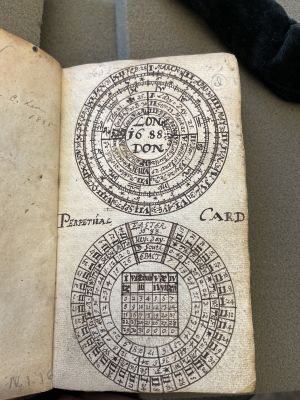
Perpetual card: Vaticina Varia is a manuscript hand-written by an unknown author, detailing various fortune telling methods and astrological conventions. The name perpetual card means a perpetual calendar, sometimes also called an infinite calendar. This manuscript contains a calendar for the year of 1688, explanations on how to calculate the date for feasting and traditional holidays, as well as extensive examples and notes on astrological predictions. Perpetual card approaches the art of fortune-telling through numeric calculations, Christian traditions, and astrological observations. This manuscript was originally collected by the Henry Charles Lea Library, and now stored in theKislak Center for Special Collections, Rare Books and Manuscripts at the University of Pennsylvania.
Manuscript Structure
The book begins with a title page of a circle illustration with the words “London 1688” written in the middle (see photo 1.1). Numbers and dates surround the words in the middle. It is thus inferred that the manuscript was written in the year 1688, in London. However, this may not necessarily be the time that this manuscript was bound together into a notebook with gilt calf. From eye observation, the calf binding appears to be from a much newer date (see photo 1.2).
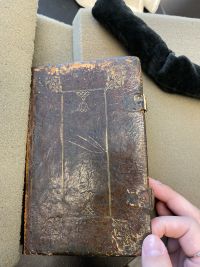
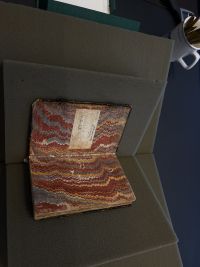
There is a possibility that the book may have been rebound again by the collector or later readers. The patterns on the calf are delicately pressed and adorned with gilt. On the right side, there appear to be two metal locks, perhaps purposed for locking the content of the book away from common readers. Whether these locks were initially created to be functional or ornamental remains a question. If these locks were functional, they, in part, reflect the nature and history of astrological fortune-telling. Manuscripts like these were not written for the masses but rather for a small number of people who studies the occult. The methods and calculations for astrological predictions were largely exclusive to certain groups of people and not easily accessible. At its present stage, the metal locks do not appear to retain any particular purpose (i.e. locking up the text).
Another clue to why the manuscript may be written and bound at different time periods lies in the pattern of the marbled paper glued between the outer calf layer and the first page. This manuscript begins and ends with sheets of delicately-created marbled paper, consisting of deep red, sky blue, white, and light yellow oil colorings (see photo 1.3). This marbled paper is made in the nonpareil pattern,[1] which was seen predominantly in 19th and 20th century.[2] One theory could be that the manuscript was first written in 1688, but later bound together into a notebook with a nice calf book cover by a collector, one or two centuries later. The date indicated on the title page possibly does not match that of the cover and the marbled paper.
The entire manuscript consistently employs brown or black colored ink to write notes, to draw astrology patterns and signs, as well as to outline and shade themed illustrations.
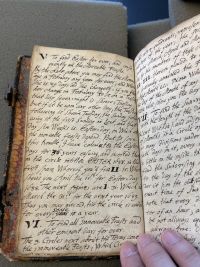
Book Content
This manuscript tackles a diverse range of topics, demonstrating methods of astrological calculations and predictions that require prior knowledge in the field.
The entire manuscript was numbered by its author in terms of pages. It begins with some handwritten notes in English, explaining in detail how to use the perpetual calendar to calculate festivals and important dates of a year, including the date for Easter and for feasts (see photo 1.4). The first twelves pages of English notes are separated from the rest of the book, marked from “i” to “xii”. After the introductory notes, the manuscript officially begins on page “1”. Starting from this page, the writer turns to using Latin as the language of communication.
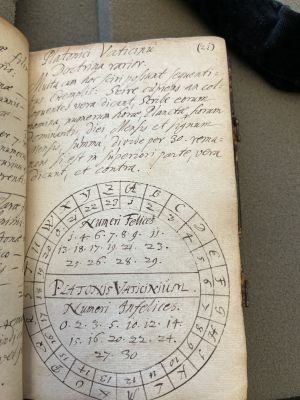
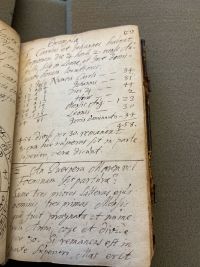
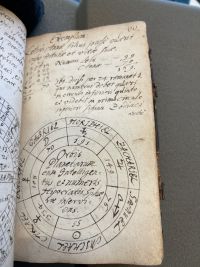
The writer then dedicates a large amount of time in the following pages to explain a fortune-telling technique that relies on numeric calculation. From page 1-55, the author creates many signature circle illustrations containing the alphabet of 26 letters (see photo 1.5). In these circles, each letter is assigned a number. The number is not fixed, but seems to be dependent on a case-by-case basis. The method of assigning numbers to letters is unknown. On every page that contains a signature circle illustration follows example calculations done by the author (see photo 1.6). The author demonstrates how to implement this method of numeric prediction, adding together the values assigned to each letter of a person's name.
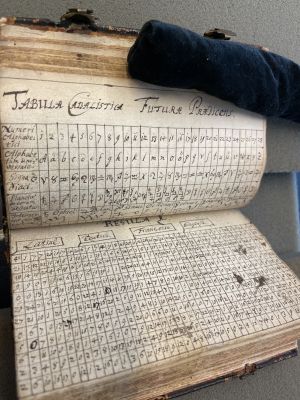
Eventually, as the manuscript progresses, more elements are added to the circle, including archangels, the twelve horoscope signs, Latin phrases, and the classical planets (see photo 1.7). The simple circle illustrations, drew by delineating around a compass, developed into diverse, nuanced methods of calculating a person's lucky numbers. Though not any illustrations of these exact fashions could be discovered online, associations can be made between this manuscript and the work of earlier occultists such as John Dee and Johannes Trithemius, whose work also employs extensive numeric calculations, knowledge of Christian traditions, and a similar circle illustration pattern. This manuscript fits into a greater genre of astrological fortune-telling notebooks, purposed to compile together the centuries of astrological wisdom as well as adding in the author's personal touch and edits to the systems of calculation. The origin of these prediction methods cannot necessarily be traced back to one particular author, but can be attributed to the culmination of work done by astrology enthusiasts and knowledge passed down through the generations.
Beginning on page 56, the manuscript lists a calendar-like table with various signs representing the classical planets (see photo 1.8). A similar form is seen on page 64 where different numbers are also incorporated onto the table. The meaning and function of these tables remain rather elusive. It is interesting to note that at the top of the page, the author lists the names of four European languages: Dutch, French, English, and Latin. It could be possible that this manuscript was circulated among astrologers of different nations or royal courts. Another possibility could be that the author, who had added English introductions in the beginning of the manuscript, appropriated fortune-telling methods and astrological traditions from other European countries. The author could have set up the table in a way that it could be used by speakers of these four languages. Historically, in the Tudor Renaissance period, astronomical tables found in astrological manuscripts had to be adjusted to fit English use.[3]
Within the table, numbers, the twelve horoscope signs, and the classical 12 planets were all mentioned. Depending on the page, sometimes, distinct black ink markings could be spotted. The ink markings are often times circles on numbers or corrections made to the numbers on the table. The ink color is very different from the brown ink in which the table was originally written and outlined. It could then be deduced that this manuscript successfully circulated among a group of people who have an in-depth understanding of astrological observations. Without a high-level understanding of this topic, authors of these marginalia would not be able to add onto each other's work.
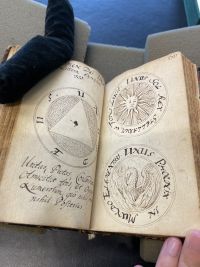
Starting from page 70, the author starts drawing out patterns that appear to hold a lot of historical significance in the art of fortune-telling and astrology studies (see photo 1.9). On page 71, a sun and a phoenix being reborn in the fire were vividly depicted on the page. Christianity has traditionally taken meaning in phoenix, adopting it as a symbol of death and resurrection, sometimes used as a metaphor for the resurrection of Jesus Christ. It can thus be concluded that these methods of astrology are rooted in a Christian belief,[4] as well as the Greco-Roman traditions of gods and goddesses. The story of Adam and Eve is also hand-drawn in the manuscript (see photo 2.). The drawing utilizes lines to serve as shading and create a sense of 3D space within the 2D paper.
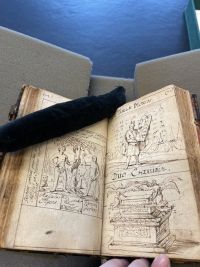
The manuscript continues to delve further into different techniques of fortune-telling throughout the rest of the book. Beginning on page 100, the author of the manuscript begins experimenting with a different form of calculation that depicts an octagon drawn inside a circle (see photo 2.1). This method seems to be relying on numeric calculations to find dates or numbers that correspond with various conditions of life. While most words remain hard to decipher, some Latin phrases could be translated to understand the illustrations. For example, on page 102, Latin words such as life, fortune, and health disclose the purpose of these circle illustrations. The author is using some form of numeric calculation to help predict the life path of various individuals.
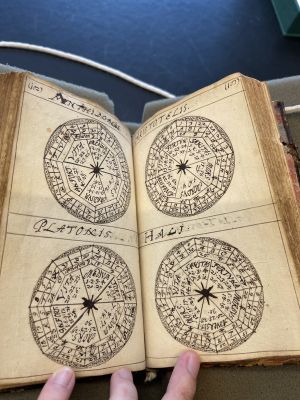
Speculations
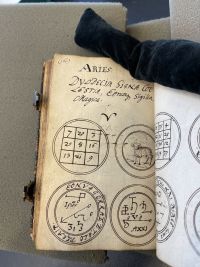
It may be suspected that this manuscript is intended to serve as a guide for those who may hope to learn more about astrology, fortune-telling, or just to use basic methods to help oneself identify lucky numbers and relevant astrological observations. This is because, at the end of the manuscript, the author dedicates a section explaining, through concise illustrations, the numbers and icons relevant to the twelve horoscopes (see photo 2.2). The graphic nature of these pages indicates that it was meant for an audience, not just for record-keeping purposes for the writer. The page number ends on 193.
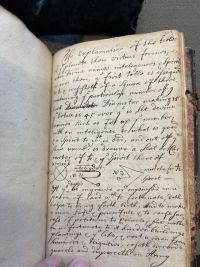
However, additional blank pages were added and pencil marked page numbers continued. This time, a new style of handwriting continued the manuscript by writing some notes in English relevant to astrological observations (see photo 2.3). The handwriting is distinctively different because the writer employs a completely different method of writing the letter “f”. The existence of such notes meant that this notebook was passed around by different people, and potentially purposed to be a guide being distributed among astrology admirers. The manuscript ends with several blank pages, almost as if it was compiled together for future readers to add in further notes. Eventually, the readers reach the closing marbled paper and back cover, with a note indicating that the book was collected by the Henry Charles Lea Library (see photo 2.3).
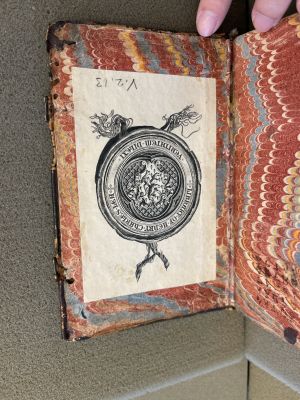
To what extent is this knowledge of fortune-telling contained in this manuscript readily available to the general public remains unknown. The manuscript could be circulated or borrowed within an exclusive group such as the Society of Astrologers(C.1647 - 1684) mentioned in Michelle Pfeffer's article, an exclusive society located in London spanning the late 1600s.[5] Or it could have been a manuscript regularly borrowed by any person of interest. The lock we observe on the outer calf further complicates the question of manuscript accessibility.
References
- ↑ “Vintage 19th c. Marbled Paper, Nonpareil Pattern.” University of Washington Libraries, Special Collections, [DEP0110]. Accessed April 1, 2022. https://digitalcollections.lib.washington.edu/digital/collection/dp/id/283/rec/8.
- ↑ Tanselle, G. Thomas. “The Bibliographical Description of Patterns.” Studies in Bibliography 23 (1970): 71–102. http://www.jstor.org/stable/40371502.
- ↑ Carey, Hilary M. “Henry VII’s Book of Astrology and the Tudor Renaissance.” Renaissance Quarterly 65, no. 3 (2012): 661–710. https://doi.org/10.1086/668299.
- ↑ Barnes, Robin Bruce. Astrology and Reformation, 2015, https://doi.org/10.1093/acprof:oso/9780199736058.001.0001.
- ↑ Pfeffer, Michelle. “The Society of Astrologers (C.1647–1684): Sermons, Feasts and the Resuscitation of Astrology in Seventeenth-Century London.” The British Journal for the History of Science 54, no. 2 (2021): 133–53. doi:10.1017/S0007087421000029.